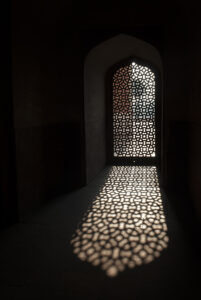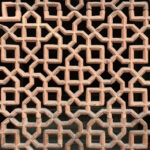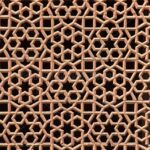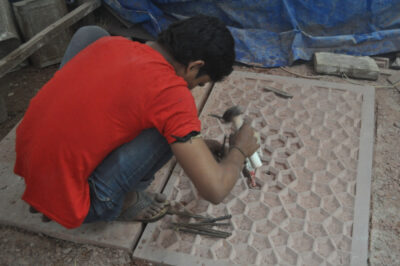Humans have always been fascinated by the natural phenomenon around them and even more eager to control them. The answer to two of the most common natural elements, light and air, was Jaali. The Jaali, which means net in Hindi, is a piece of stone or wood filled with delicately carved patterns and perforations. This piece of craft ornaments several structures since ancient times as windows, doors, screens, partitions, furniture or just as decorative objects. A skilled artisan requires just a humble chisel and hammer to combine decorative art with functionality. It sit as a symbol of past in several architectures of Delhi no matter the period.
Beauty and Science

As said, a jaali serves two purpose, first as a pleasing addition in architecture and second to limit and control the entry of light and air. This is the reason it is highly used in the hot summer regions with excessive sunlight. When light passes through the lattices it softens the heat and harshness. This also creates enigmatic shadows on the floor depending on the designs and patterns. This play of light changes during night time with rays of lamps and bulbs ornamenting exterior. The aesthetics created by a even a single Jaali can be different according to the seasons, time and location of the viewer. If seen from outside it completes the structure designs, reduces weight of the elements and offers privacy for the inhabitants, and similarly viewed from inside the patterns and motifs are thrown on the floor with the shadow and fills the room with light just enough for serene living.
The lattice not only divides the light but also breaks the air in doing so the air cools down. It is called The Venturi Effect that is when air passes through small holes, it gets compressed losing heat in the process and when released it gets accelerated. Even modern air conditioning units work on the same principle. Thus, due to the Venturi Effect a jaali can fill the room with pleasing cool air even with warm light breeze outside.
This is the reason the architectural feature got really famous in areas with recurring heatwaves like north India specially structures of Delhi and without modern technology this was the best option. It was the pride of palaces and shine of sanctuaries, not only for elites it was widely being used in verandas, courtyards and balconies of normal housings.
Genesis and Zenith
This feature do exist in several architectures all across the subcontinent and even in Mediterranean areas with their own changes suitable for environment. While the origin of Lattice in other countries are highly debatable, in India it was started during the Mauryan Empire.

It is evident from ancient treatise on temple architecture The Manasara, Brihat Samhita and Mayamata. The texts contain lexicon of Sanskrit terms for jaali and their designs commonly using the word jalaka. The jaali’s ventilating and illuminating effect was particularly useful for spiritual meditation and encouraging devotion. Many sanctuaries, shrines and temples included it in their structures. Wood screens were being used for this purpose which sadly do not survive the hot humid climate.
It was picked up by the Delhi Sultanate combining it with the arabesque symmetrical designs and making it a staple for every kind of Indo-Persian architecture. They used white marbles and red sandstones to create these screens. Their works still visible in the Qutb Complex in Qutb Minar and Alai Darwaza. However the peak of Jaali cutting craft was reached during the reign of Shah Jahan and the creation of Shahjahanabad. The Red Fort shows the zenith of artistic creativity and lavish decorations. Its famous Scales of Justice screen in Diwan-i-khaas represents the artistic skill of Delhi’s artisans combined with the patronage of Mughals.
Motifs and Symbolism

Jaali screens have been associated with sacred architectures from the earliest times. Evidently even the screens held the beliefs that structure was supposed to convey. The lattices can be found with both unpredictable random patterns and auspicious motifs. It is a conveyor symbols and philosophies a mix of solids and voids, concave and convex, lines and curves, light and shadows. Some of the most common patterns visible are :-
Geometric Patterns: The most easily found pattern is of square with horizontal vertical lines, sometimes they are rotated to create diagonal openings. In certain structures they are made to create a swastika symbol. Other miscellaneous patterns include triangles, quarter-circles, cutout zigzag bands, octagons etc.

Stars and hexagon: This motif was majorly used by Delhi Sultanate in the decoration of domes, minars and muqarnas. It’s illumination was supposed to represent a starry sky and astral features. This symbolic use of sunlight became the most prominent part of medieval world.

Floral pattern: The introduction of flowers like tiny lotuses, growing buds, rings of petals, vines, and diamond shaped flower is the result of artistic innovation and patronage. It was most widely used by Shah Jahan and his imperial atelier in contemporary architectures.
Jaali Cutting and Today
Due to the aesthetic qualities, flexibility in use and important functions this craft have still survived today. It uses modern technology of laser cutting or CNC tools to create the lattices on cement or metal surfaces. This has led to the decrease in quality handcrafted products of wood and stone. The craft also faces other challenges like decline in the number of artisans practicing this trade. The rise in costs of raw materials and tools in an already limited market was of no help either.
However several schemes and initiatives have been started to preserve and promote these traditional crafts like PM Vishwakarma scheme and USTTAD with organizations like Delhi Craft Council. They help in developing modern marketing skills and training young artisans for the revival. Thankfully, due to the efforts this art is still flourishing among the masonry and workers of Old Delhi.
Conclusion

Jaali cutting is one of the oldest crafts still alive in Indian subcontinent. It has survived great testimonies of time due to the realization of it’s great metaphorical, decorative and functional potential. The jaali evolved from a minor feature to the key characteristic of architectural style. Serving its purpose in sanctuaries, gardens, palaces, forts, tombs, temples, mosques etc. It is the achievement of human creativity, a portal between world of men and nature.
References
- Haider, Navina Najat. Jali: Lattice of Divine Light in Mughal Architecture. Mapin publishing.
- Lerner, Martin. The flame and the lotus : Indian and Southeast Asian art from the Kronos collections. The Metropolitan Museum of Art. pp 156-157.
- Azmi, Feza Tabassum. How India’s lattice buildings cool without air con. BBC.com
- Jali Cutting: An Intricate Traditional Craft of South Asia. Jaipurcncwork.com




